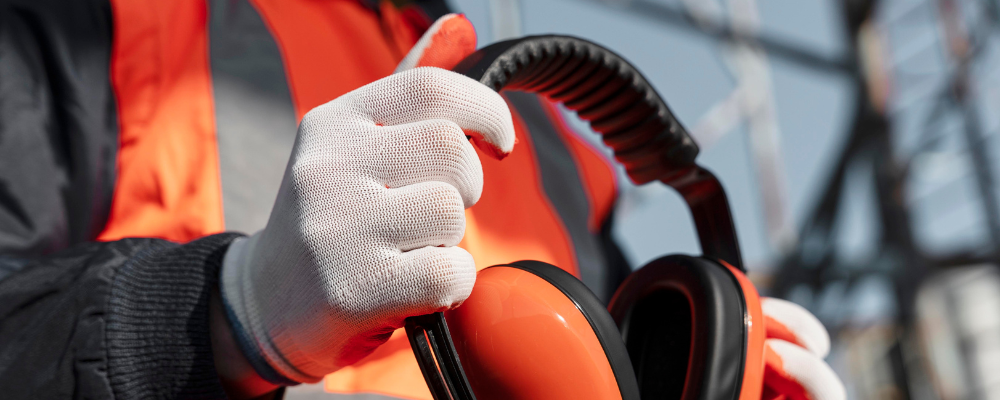
Introduction
In the dynamic and hazardous realm of construction, safety is paramount. Construction workers face many risks daily, and prioritizing their well-being is non-negotiable. This blog sheds light on a critical safety measure—hand guards—and explores their significance in the construction industry. Let’s delve into the technical aspects and explore a range of products designed to safeguard the hands of construction workers.
Understanding the Need for Hand Guards
1.1 The Construction Landscape
Construction sites are dynamic environments that combine heavy machinery, intricate tools, and challenging working conditions. The amalgamation of these elements poses a considerable risk to the safety of workers. Amidst the hustle and bustle of construction activities, hands emerge as particularly vulnerable to injuries. The constant handling of materials, operation of power tools, and exposure to various substances heighten the susceptibility of hands to potential hazards.
1.1.1 Heavy Machinery and Tools
Construction sites are marked by heavy machinery such as excavators, cranes, and bulldozers. The operation of these machines requires precision and skill, often putting workers near moving parts. Additionally, using sharp and powerful tools, from saws to drills, further intensifies the risks construction workers face.
1.1.2 Challenging Working Conditions
The construction landscape has many challenges, including uneven terrain, inclement weather, and tight spaces. These conditions add a layer of complexity to the tasks at hand, increasing the likelihood of accidents and injuries.
In this context, construction workers’ hands become an integral focus point. It is crucial to recognize that protecting the hands is a matter of individual well-being and a critical factor in ensuring construction operations’ overall efficiency and safety.
1.2 The Role of Hand Guards
Handguards, primarily gloves, emerges as a fundamental line of defense against the risks inherent in the construction environment.
1.2.1 Barrier Against Physical Hazards
Handguards act as a physical barrier, protecting construction workers from potential hazards. This includes shielding against abrasions caused by rough surfaces, cuts from sharp objects or tools, and impacts from heavy materials. The durability and design of hand guards are engineered to withstand the rigors of the construction site, providing a reliable shield for the hands.
1.2.2 Protection Against Chemical Exposure
In addition to physical hazards, construction workers often encounter various chemicals and substances that can threaten their skin. Hand guards designed with chemical-resistant materials protect against harmful substances, preventing direct contact with the skin and potential absorption of hazardous materials.
1.2.3 Overall Risk Mitigation
The role of hand guards extends beyond individual protection; it contributes to the overall risk mitigation strategy on construction sites. By implementing proper hand protection measures, employers ensure a safer working environment, reducing the likelihood of injuries, downtime, and associated costs.
In essence, hand guards play a pivotal role in preserving the well-being of construction workers. They serve as proactive measures to mitigate risks, uphold safety standards, and contribute to the overall efficiency of construction operations. Recognizing the importance of handguards is a crucial step toward fostering a safety culture in the construction industry.
Exploring Essential Hand Guard Products
2.1 4202 Welding Gloves
Welding is an integral part of construction work, and the need for specialized protection comes with it. The 4202 Welding Gloves provide heat resistance and dexterity, ensuring welders can perform their tasks safely and efficiently.
2.2 DermiFlex Safety Gloves Black
The DermiFlex Safety Gloves Black offers a versatile solution for general construction tasks. These gloves boast enhanced grip and durability, making them suitable for various applications, from handling materials to operating tools.
2.3 MCR Safety® Pigskin Leather Drivers
Crafted from pigskin leather, these gloves offer a unique combination of toughness and flexibility. Ideal for tasks requiring precision and tactile sensitivity, MCR Safety® Pigskin Leather Drivers are a must-have for construction workers who need reliable hand protection without compromising dexterity.
2.4 Flexo Grip Nitrile Safety Glove Grey
The Flexo Grip Nitrile Safety Glove Grey is engineered for superior grip and resistance to oils and chemicals. Construction workers dealing with slippery or potentially hazardous substances will find these gloves indispensable for maintaining a secure hold on tools and materials.
2.5 Radians® AXIS™ Cut Protection Level A2 Foam Nitrile Coated Gloves
Cut protection is paramount in construction, especially when working with sharp materials. The Radians® AXIS™ Cut Protection Gloves provide Level A2 cut resistance, ensuring that construction workers can confidently handle sharp objects and reduce the risk of injuries.

Choosing the Right-Hand Guard for Your Construction Task
1.1 Understanding Hand Guard Specifications
In construction safety, the meticulous selection of handguards is crucial to ensure workers are adequately protected against the diverse hazards they face. This section delves into the technical specifications of hand guards, shedding light on key factors that dictate their effectiveness.
1.1.1 Material Composition
Different construction tasks demand varied materials in hand guards. For instance, welding gloves require heat-resistant materials to shield against extreme temperatures, while tasks involving chemical exposure may necessitate gloves made from resistant materials such as neoprene or nitrile.
1.1.2 Cut Resistance
Construction workers handling sharp tools or materials necessitate hand guards with high cut resistance. Explore the various levels of cut protection available in gloves, emphasizing the importance of selecting gloves that align with the specific risks associated with the task at hand.
1.1.3 Grip Capabilities
The grip is paramount in construction tasks, especially those involving heavy machinery. Discuss the significance of gloves with enhanced grip capabilities, such as textured surfaces or coated palms, to ensure workers can maintain a secure hold on tools and materials, ultimately mitigating the risk of accidents.
1.2 Tailoring Hand Guard Selection to Job Roles
Recognizing that each construction job role has unique challenges, it is imperative to tailor hand guard choices accordingly.
1.2.1 Concrete Work
Construction workers involved in concrete work often face abrasion risks due to the coarse nature of the materials. Highlight the benefits of gloves with superior abrasion resistance, ensuring that these workers are adequately protected against wear and tear.
1.2.2 Metal Handling
For those handling metal, the risk of cuts and punctures is prominent. Emphasize the importance of prioritizing cut protection in hand guards designed for tasks involving metal, showcasing gloves with advanced materials and technologies specifically engineered to mitigate these risks.
1.3 Testing and Certification
Understanding hand guard testing and certification standards is paramount in pursuing optimal safety.
1.3.1 Industry Standards
Delve into recognized industry standards for hand guards, such as EN388 for mechanical and EN407 for thermal risks. Explain how adherence to these standards ensures that hand guards meet or exceed predefined safety benchmarks.
1.3.2 Site and Safety Solutions Assurance
Assure construction workers that the hand guards provided by Site and Safety Solutions undergo rigorous testing and adhere to industry certifications. Transparency in testing methodologies and compliance ensures that workers can trust the reliability and effectiveness of the handguards they use on the job.
The Long-term Benefits of Investing in Quality Hand Guards
2.1 Reducing Workplace Injuries and Downtime
Quality hand guards are proactive in reducing hand-related injuries on construction sites, leading to a substantial decline in workplace accidents and subsequent downtime.
2.1.1 Statistical Data
Present statistical data showcase the correlation between using quality hand guards and decreasing workplace injuries. Highlight case studies or industry reports illustrating the tangible impact of investing in reliable hand protection.
2.1.2 Real-world Examples
Provide real-world examples where construction companies significantly reduced workplace injuries after implementing high-quality hand guards. Such examples serve as compelling evidence of the effectiveness of proper hand protection.
2.2 Enhancing Worker Productivity and Efficiency
Beyond injury prevention, quality hand guards contribute to the overall well-being of construction workers, positively impacting their productivity and efficiency on the job.
2.2.1 Comfort and Design
Explore how comfortable and well-designed handguards contribute to improved worker comfort. Discuss ergonomic designs, breathable materials, and features that reduce hand fatigue, enabling workers to perform tasks with greater ease and focus.
2.2.2 Dexterity and Precision
Highlight how the right-hand guards enhance worker skill and precision. Workers can execute tasks with greater accuracy when their hands are adequately protected, ultimately leading to heightened efficiency in construction operations.
2.3 Long-term Cost Savings
Investing in quality hand guards is not just a safety measure; it’s a strategic move that yields long-term cost savings for construction companies.
2.3.1 Minimizing Medical Expenses
Examine how preventing hand injuries through reliable hand guards contributes to minimizing medical expenses. Fewer workplace injuries mean reduced reliance on healthcare services, translating to significant cost savings for employers and employees.
2.3.2 Insurance Claims and Legal Issues
Illustrate how a proactive approach to hand protection minimizes the likelihood of insurance claims and potential legal issues. Construction companies can build a solid foundation for long-term financial stability and legal compliance by prioritizing worker safety through quality hand guards.
In conclusion, the careful consideration of hand guard specifications, customization based on job roles, and adherence to testing and certification standards are critical steps in ensuring the safety of construction workers. Moreover, the long-term benefits of investing in quality hand guards extend beyond safety, positively impacting workplace efficiency and contributing to substantial cost savings for construction companies. Site and Safety Solutions remain committed to providing hand guards that meet technical requirements and deliver tangible and enduring benefits to the construction industry.
Best Practices for Hand Guards
- Cleaning
- Drying
- Inspection
- Storage
For more information, visit our website and Facebook page.
Here are some products :
MCR Safety® Pigskin Leather Drivers
Flexo Grip Nitrile Safety Glove Grey
Radians® AXIS™ Cut Protection Level A2 Foam Nitrile Coated Gloves
Conclusion
In conclusion, prioritizing hand protection is not merely a safety measure but a necessity in the construction industry. Handguards, in the form of specialized gloves, offer a comprehensive solution to mitigate risks and enhance the overall safety of construction workers. By investing in quality hand guards such as the 4202 Welding Gloves, DermiFlex Safety Gloves Black, MCR Safety® Pigskin Leather Drivers, Flexo Grip Nitrile Safety Glove Grey, and Radians® AXIS™ Cut Protection Gloves, construction companies demonstrate their commitment to the well-being of their workforce.
As the construction industry evolves, the importance of adopting and implementing advanced hand guard technologies cannot be overstated. By integrating these protective measures into daily practices, construction workers can confidently carry out their tasks, knowing that their hands are shielded from the myriad hazards on the job site. Site and Safety Solutions remain dedicated to providing top-tier hand guards, ensuring every construction worker can focus on their craft without compromising safety.










